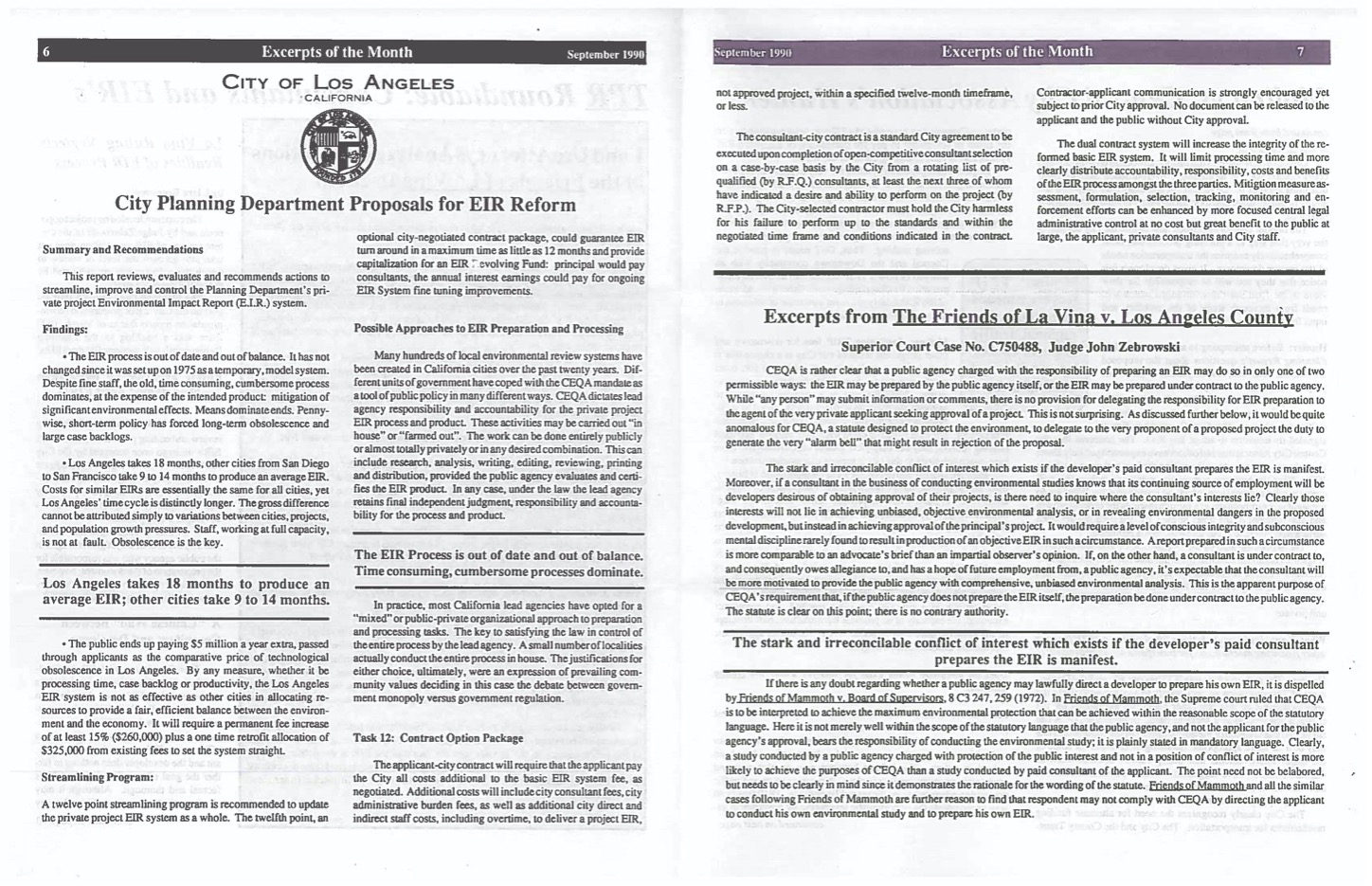The Friends of La Vina decision has ruled that "the County of Los Angeles could not comply with CEQA by allowing a developer to prepare its own EIR." Ken Bernstein, Editor of The Planning Report, pulls aside the level of uncertainty that the La Vina decision has brought. Alongside another court decision, Bernstein affirms that the La Vina decision will not have any long-lasting impact to the EIR process.

“The biggest effect of the La Vina decision may be the addition of another layer of uncertainty to the development process.”
The convergence this summer of a Los Angeles Superior Court case, a proposal from the City of Los Angeles, and a rarely invoked state law may bring changes in the way Southern California governments prepare environmental impact reports (EIR’s).
About half of California cities and counties allow applicants to submit their own draft EIR’s, to be reviewed and edited by the lead public agency. As the excerpt on right hand-side of the image below details, Los Angeles Superior Court Judge John Zebrowski on July 30th ruled that the County of Los Angeles could not comply with CEQA by allowing a developer to prepare its own EIR. Judge Zebrowski’s decision has triggered uncertainty in the Southern California land-use community.
Though the Friends of La Vina decision in the short-run may bring changes to the EIR process, it will not likely herald the immediate end to applicant-drafted EIR’s.
Most importantly, a Superior Court judge’s ruling does not bind anyone except the parties to the litigation. And just days before the La Vina decision, Judge David Yaffee from the same Superior Court ruled in Sierra Club v. County of Los Angeles directly to the contrary: that the County could use an EIR drafted by an applicant so long as it performed the type of review that would enable it to adopt the report as its own. The County may also choose to appeal the La Vina decision.
The biggest effect, pending other court decisions supporting Judge Zebrowski, will be the addition of another layer of uncertainty to the development process.
While developers/applicants may continue to prepare EIR drafts, the decision may lead localities to give these drafts greater scrutiny. “Counties need to do a better job of documenting the review we are performing and be very cautious to be sure that we are carefully reviewing the document,” says Charles Moore, the Principal Deputy County Counsel for Los Angeles County on land use issues.
City of Los Angeles’ Planning Department Proposes EIR Reforms
Even before Judge Zebrowski’s decision was announced, the City of Los Angeles’ Planning Department and Mayor Bradley had already proposed a twelve-point EIR reform package.
The first eleven proposals are largely noncontroversial streamlining measures, relying heavily on intradepartmental reforms to speed the dilatory EIR process. “The biggest technological innovation in that unit in the past 15 years was an electric pencil sharpener,” says Bradley Crowe, a former aide to Mayor Bradley and presently the Planning Department staffer responsible for reviewing the City’s EIR procedure.
Crowe’s twelfth proposal represents a more controversial change: developers would essentially be given the option of trading control over the EIR process for time. It proposes a contract package in which developers would have the option of paying an additional fee to an EIR Revolving Fund and allowing the City to choose the EIR consultant. In return, the City would guarantee that the EIR would be processed within a specific time period, perhaps as little as 12 months.
Such a change would represent a major break from present procedure. Indeed, the City may actually lack the capacity to live up to its end of the bargain until the internal reforms are implemented. Homeowners groups, led by Barbara Fine of the Federation of Hillside and Canyon Associations, believe the proposed reforms do not go far enough in providing for financial independence and in citizen participation in the environmental review process. Further affirmations of the La Vina decision might mean that the City’s choice of an optional system would not pass judicial muster.
Due to the large volume of public comments received during the August 23rd meeting, the Planning Department’s EIR package will be heard again by the Commission on September 27th.
The Sudden Ascension of the Permit Streamlining Act
Further complicating the already muddled EIR process has been the sudden emergence of the heretofore little-noticed Permit Streamlining Act.
When delays resulted in a mini-mall development on Venice’s Ocean Front Walk due to inaction by the City’s Department of Transportation and the Planning Department, the developers’ attorneys dusted off the Act. Passed in 1977, the Permit Streamlining Act requires localities, with some exceptions, to act on a negative declaration within six months, and to complete an EIR within 12 months. If the locality fails to do so, the project is deemed approved. On the Venice development, the L.A. City Attorney’s office sided with the developer, agreeing that the Permit Streamlining Act applied since the project had been delayed 18 months.
Last month, the Venice North Beach Coalition, a Venice citizens group, filed suit against the city, claiming that the environmental review required by CEQA was never completed. The case will be heard in the Los Angeles Superior Court within the next six months.
How Will Localities React?
Together with the Zebrowski decision, this case may encourage localities to reform their EIR procedures. At the very least, the sudden specter of the Permit Streamlining Act may prod localities to keep a closer eye on deadlines, perhaps speeding the EIR process. Some localities may instead require certain technical information, such as geologists’ studies, before the EIR clock starts. And some developers may be reluctant to press localities on the Act’s time limits for fear their projects will simply be denied.
With all three of these developments, uncertainty appears to be the watchword for the coming months. What is certain is that the new questions raised about CEQA will send developers scurrying to their land-use attorneys, some of whose interpretations The Planning Report offers this month here. Excerpts from the La Vina decision and the Planning Department’s staff report appear in this page above.
- Log in to post comments




